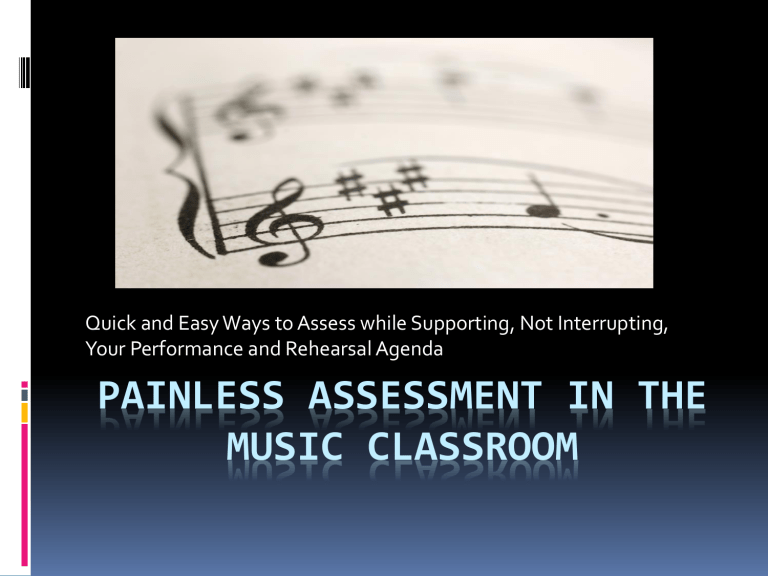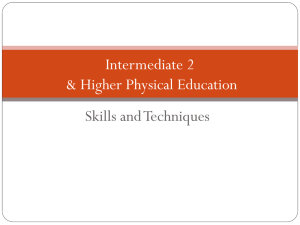Painless Assessment in the Music Classroom

Quick and Easy Ways to Assess while Supporting, Not Interrupting,
Your Performance and Rehearsal Agenda
PAINLESS ASSESSMENT IN THE
MUSIC CLASSROOM
Assessment Fundamentals
What is assessment?
What are some examples?
Why do we assess?
Who uses the results of assessments?
Assess what you teach
Assess based on your daily musical objectives
Typical beginning band, orchestra, etc.: lines from a method book, scales
Typical ensemble with experienced students: assess the literature students are preparing, scales, rudiments, technical etudes
Jazz ensemble: improvisational skills
What do you assess?
Now that you have the material selected, what do you listen for?
Correct pitches and rhythm – what else?
Practice Assessment
Read your rating sheet
Listen to the recording
Assess what you heard
How did we rate our clarinettist? Please share your total score at the bottom.
Define your expectations
What might be good for a beginner might not be good for an experienced student!
Formative versus summative assessment
Summative – final ranking, trophy, medal, etc.
No information provided, just results
Formative – informs the student of how they did, where they were strong, where they were weak
Formative Assessment
What do your numbers mean?
Formative assessment leads to positive growth – but how do you inform the student?
Write detailed feedback for each student
Record yourself giving commentary as they play
Use a rubric
Designing the Rubric
The criteria on the rubric should reflect your priorities
How many criteria?
What ratings do you use?
Letters (A, B, C, D, F)
Qualitative Descriptors (Superior, Excellent, Good)
Numbers (1-3, 1-5, 1-100)?
1-3 doesn’t differentiate between students clearly
1-100 is too much: what is the difference between an
84 and an 83?
What do the ratings mean?
3-6 criteria, 5-10 ratings
For each criterion, define each level of rating.
What exactly differentiates a “5” on intonation from a “4”?
Category
Tone
Quality
Excellent 5pts Very Good 4pts Good 3pts Fair 2pts Poor 1pt
Tone is consistently focused, clear, and centered throughout the range of the instrument
Tone is focused, clear and centered through the normal playing range of the instrument. Extremes in range sometimes cause tone to be less controlled.
Tone quality typically does not detract from the performance.
Tone is generally clear with some unfocused notes. Extreme range s is slightly controlled.
Tone is often focused, clear and centered, but sometimes the tone is uncontrolled in the normal playing range. Extremes in range are usually uncontrolled. Occasionally the tone quality detracts from overall performance.
The tone is often not focused, clear or centered regardless of the range being played, significantly detracting from the overall performance.
Rhythm
Pitch
The beat is secure and the rhythms are accurate for the style of music being played.
The beat is secure and the rhythms are mostly accurate. There are a few duration errors, but these do not detract from the overall performance.
The beat is secure most of the time with some mistakes. Some duration errors.
The beat is somewhat erratic. Some rhythms are accurate. Frequent or repeated duration errors.
Rhythm problems occasionally detract from the overall performance.
The beat is usually erratic and rhythms are seldom accurate detracting significantly from the overall performance.
Virtually no errors. Pitch is very accurate.
An occasional isolated error, but most of the time pitch is accurate and secure.
Mostly accurate pitches with some errors. About a 60/40 ratio of correct to wrong notes
Some accurate pitches, but there are frequent and/or repeated errors.
Very few accurate or secure pitches.
Articulation Tonguing and sticking are accurate for entire selection.
Most of the notes are clearly articulated, with a
"dah" sound (rather than a
"TUT" sound).
There is some separation between notes; student is able to fix these errors with teacher direction.
Frequently no separation between notes. Student is able to fix some errors with teacher direction.
There is no separation between notes; tonguing is not being used.
Rhythm
Intonation
Articulation
Posture
Poor Fair Average Above Average Excellent
Performer is off beat, not counting, playing incorrect rhythms
(5 or more mistakes)
Performer plays with inaccurate air stream and is not in tune
(5 or more mistakes)
Performer plays little to none of the correct articulation
(5 or more mistakes)
Performer is slouching, unenthused, and not conveying the mood of the piece
(5 or more mistakes)
Performer has less rhythmic mistakes and is mostly on the correct beat
(3-5 mistakes)
Performer is slightly in tune and plays with less focused air
(3-5 mistakes)
Performer plays some of the correct articulation (3-5 mistakes)
Performer looks uncomfortable and barely conveys the mood of the piece
(3-5 mistakes)
Performer has few rhythmic mistakes
(2-3 mistakes)
Performer has a fair number of intonation issues
(2-3 mistakes)
Performer plays an average number of correct articulation
(2-3 mistakes)
Performer somewhat conveys the mood of the piece and slightly slouches
(2-3 mistakes)
Performer is mostly plays accurate rhythms
(1-2 mistakes)
Performer is mostly in tune and plays with good air
(1-2 mistakes)
Performer plays most of the correct articulation
(1-2 mistakes)
Performer mostly conveys the mood of the piece and sits properly
Performer plays correct rhythms
(0 mistakes)
Performer plays with focused air stream and is in tune
(0 mistakes)
Performer plays all of the correct articulation
(0 mistakes)
Performer conveys the mood of the piece to the audience and sits/stands properly
Tone Quality
5- The tone is very full and obviously backed by good breath support
4- The tone is mostly good with a few spots that could be improved
3- The tone quality is okay but somewhat thin
2- The tone quality is thin or breathy
1- The tone quality is very unclear and thin
Technique
5- Posture, embouchure, and the hold on the instrument are all very good
4- Posture, embouchure, and the hold on the instrument can be improved in several places.
3- Posture, embouchure, and the hold on the instrument needs overall work
2-Posuture, embouchure, and the hold on the instrument are poor
1-Very poor posture, incorrect embouchure, and impractical hold on the instrument
Correctness of Pitch
5- All of the pitches were right and fingered correctly
4- Most of the pitches were right and fingered correctly
3- A fair number of the pitches were right and fingered correctly
2- Many of the pitches were wrong/ fingered incorrectly
1- Student obviously has no understand of the fingerings for the piece.
Correctness of Rhythm
5- The piece is played at an appropriate tempo with correct rhythms
4- The piece is played at an appropriate tempo with occasional hesitations
3- The piece is somewhat slow with several hesitations
2- The tempo is inconsistent with many hesitations
1- The tempo is hard to find and rhythms aren’t correct at all
Strategies for Implementation
Now that you have it, how do you use implement it with a 50-piece ensemble?
Assess all 50 students in one day
In regular classroom setting
In sectionals
Assess a few sections each day
Takes relatively little time and doesn’t break your overall rehearsal momentum
Uses of Assessments
Now that you’ve done the assessment, what can you do with this information?
Student grades
Chair placement
Baseline data to set future goals
Determine where to concentrate greater attention during rehearsals








